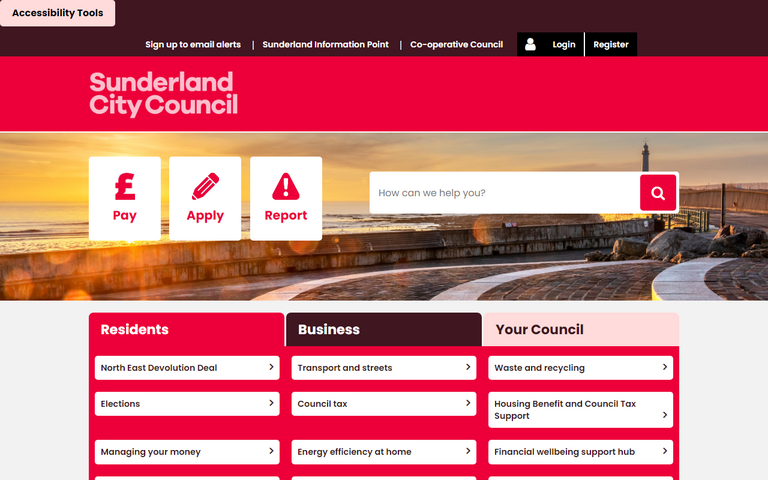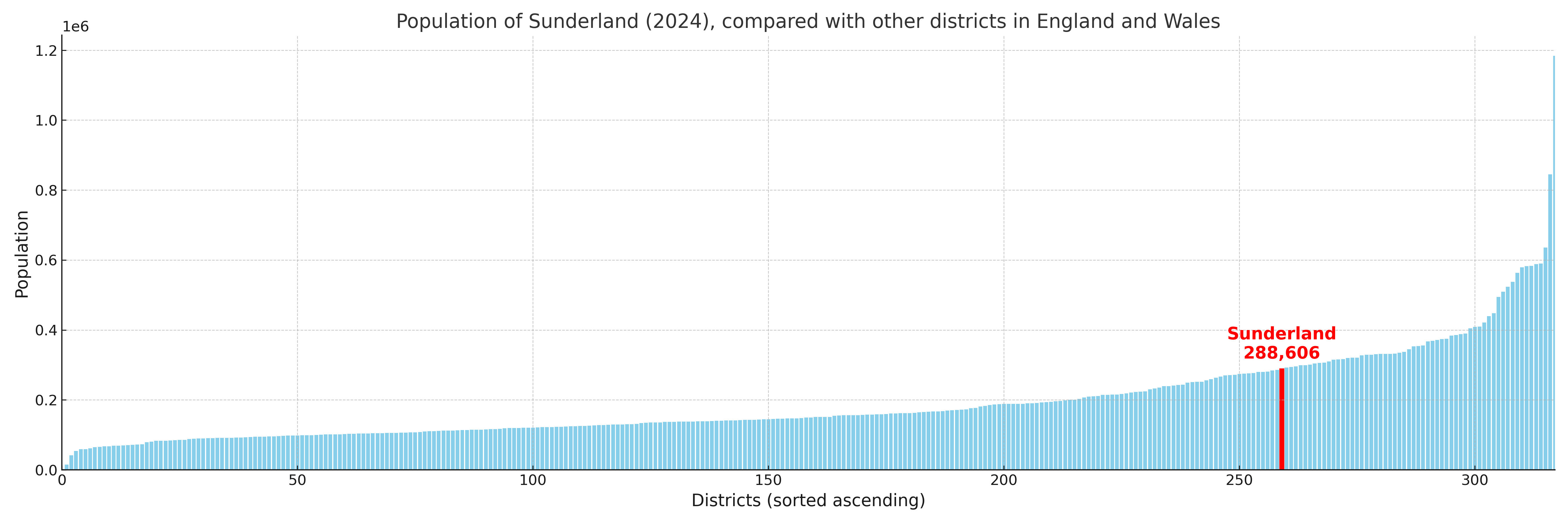Sunderland
§ This page gives an overview of the Sunderland local authority district, bringing together key facts, maps, and data to help you quickly understand the area. One of 361 district profiles on Baseview.
Overview ⁞ Sunderland sits on the River Wear as it flows into the North Sea, with a history shaped by shipbuilding and glassmaking. Its coastline features long sandy beaches at Roker and Seaburn, while Penshaw Monument overlooks the city and countryside from its hilltop setting. The city centre offers cultural landmarks such as the Sunderland Museum and Winter Gardens, the Empire Theatre, and modern attractions like the Stadium of Light. The River Wear runs through scenic gorges and is crossed by striking bridges, while surrounding countryside and coastlines add variety to Sunderland’s geography.
Sunderland Boundary Map
This map shows the official boundary of the Sunderland local authority district, based on the latest geographic data published by the Office for National Statistics (ONS). It provides a clear view of the district’s extent and helps you understand how the area fits within the wider regional and national landscape.
Contains OS data © Crown copyright and database right 2025. Source: Office for National Statistics licensed under the Open Government Licence v3.0.
The administrative boundary of Sunderland can also be viewed on OpenStreetMap: District Boundary of Sunderland.
Key Facts about Sunderland
What region is Sunderland in? Sunderland is in the North East of England, a region within the UK.
What county is Sunderland in? Sunderland is located in the county of Tyne and Wear.
Is Sunderland a city? Yes, Sunderland is a city. Sunderland holds official city status as one of the 76 designated cities in the UK.
Who governs Sunderland? The local government for this district is: Sunderland City Council (Metropolitan District).
▶ Official website of Sunderland City Council 🔗 sunderland.gov.uk

Which police force covers Sunderland? Policing in Sunderland is provided by Northumbria Police 🔗 northumbria.police.uk, which serves 6 local authority districts: Gateshead ⁞ Newcastle upon Tyne ⁞ North Tyneside ⁞ Northumberland ⁞ South Tyneside ⁞ Sunderland.
Sunderland in International Geographies
In the International Territorial Levels (ITLs) hierarchy, Sunderland is an ITLs Level 3 area:
- (ITL 1) North East
- (ITL 2) ⇒ Northumberland, Durham and Tyne & Wear
- (ITL 3) ⇒⇒ Sunderland
The International Territorial Levels are used by OECD member countries for statistical purposes to classify administrative areas. We have this listable page for easy browsing of ITL names and codes: International Territorial Levels.
Constituencies in Sunderland
Sunderland is divided into 3 parliamentary constituencies, listed below in alphabetical order.
A constituency is a specific geographical area that elects one Member of Parliament (MP) to represent them in the House of Commons. The United Kingdom is divided into 650 parliamentary constituencies. We have this list page for easy browsing of all UK parliamentary constituencies: List of Constituencies.
Wards in Sunderland
Sunderland is divided into 25 wards, listed below in alphabetical order.
- Barnes
- Castle
- Copt Hill
- Doxford
- Fulwell
- Hendon
- Hetton
- Houghton
- Millfield
- Pallion
- Redhill
- Ryhope
- Sandhill
- Shiney Row
- Silksworth
- Southwick
- St Anne's
- St Chad's
- St Michael's
- St Peter's
- Washington Central
- Washington East
- Washington North
- Washington South
- Washington West
In the UK, a ward is a subdivision of a local authority area, used mainly for electoral and statistical purposes. Defined by the ONS, wards represent the primary unit for local elections, each returning one or more councillors to the local council. Wards are also used as a key geography for presenting population and census data.
Parishes in Sunderland
Sunderland is part-parished: 3 civil parishes (listed A-Z below) alongside 4 unparished areas.
- Burdon
- Hetton
- Warden Law
A civil parish is the lowest tier of local government in England, used for villages, small towns, and suburbs. They have their own local authority, either a parish council or a parish meeting, which provides local services like managing parks, allotments, and streetlights, and represents the community's views to larger councils.
Built-up Areas in Sunderland
Sunderland covers 17 built-up areas, listed below in alphabetical order.
- Birtley *
- Easington Lane
- East Rainton
- Fence Houses *
- Follingsby *
- Gateshead *
- Hetton-le-Hole
- Houghton-le-Spring
- Penshaw
- Shiney Row and Penshaw
- South Bents *
- South Hetton *
- Springwell *
- Sunderland *
- Washington *
- West Rainton *
- Whitburn (South Tyneside) *
In the UK, a Built-up Area (BUA) is a continuous urban area of at least 20 hectares (0.2 km²), defined by the ONS as land where buildings are generally no more than 200 metres apart, such as towns, cities, or large villages. (Note: A BUA name marked with an asterisk (*) indicates that the area is situated partly in the district of Sunderland.)
Sunderland compared with other districts in the UK
This section shows how Sunderland compares with other local authority districts in the UK, using a variety of measures and rankings.
Sunderland has 25 electoral wards.

Sunderland has a population of 288,606 (2024 mid-year estimate by ONS)

More local statistics and data for Sunderland can be found on the ONS statistics for Sunderland.